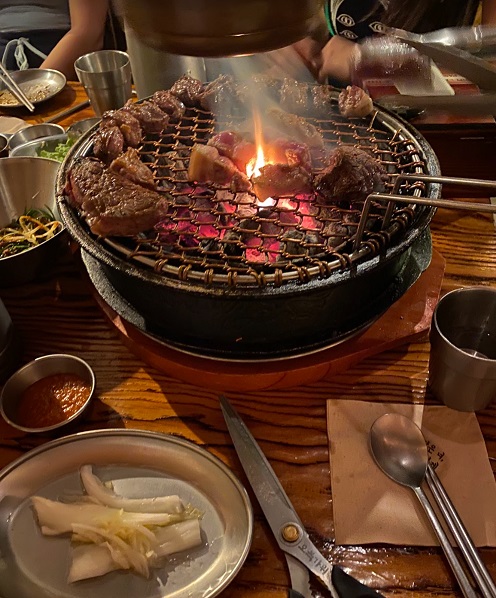One extremely popular cuisine in South Korea is Korean barbeque, but it’s not just because of the food (although the food is really good too!); it’s popularity lies within the whole cultural experience of Korean barbeque as an event that draws on ancient traditions of community and respect.
Myself and a couple other students from Yonsei International Summer School went to a Korean barbeque restaurant called 고기꾼 김춘배 (go gi goon kim choon bae). We sat down at a long table which had a mini grill on each end, charcoal already hot and flaming. In Korea, at every restaurant you go to, there is a button in the table for you to call the server and once you push the button, the server comes right away. It’s different from in the U.S. where the server comes over to the table every so often to check on you; in Korea, the server coming over to ask, “How is everything?” is considered rude and interruptive. One of my Korean friends who has studied in both Korea and the U.S. said that patience at a restaurant was one of the hardest things to learn for her at U.S. restaurants because she was so used to Korean servers coming right when needed.
So we pushed the button and ordered 삼겹살 (sam gyeob sal) which is pork belly, sort of like a thick bacon; when translated literally, 삼겹살 means “three layer flesh.” This cut of meat is so popular in Korea that the third of March is even known as 삼겹살 Day because of this three layer composition! You can order other meats too such as 살코기 (sal ko gee) or 삼갈비 (sam gal bee), which are both beef cuts, but 삼겹살 is my favorite. Within minutes, the server brought out tongs, scissors, and a plate of 삼겹살 and we began to grill. Korean barbeque also comes with many side dishes such as lettuce, green onion salad, kimchi, and dipping sauces such as garlic or 쌈장 (ssam jang) which is a spicy soybean paste with sesame seeds.

One thing that the server did not bring over were plates. Koreans like to share their meals as a way to promote community and togetherness, so there were no plates involved- you just used your chopsticks to take pieces of pork right off the grill! You can also fold the meat into the lettuce with kimchi and garlic to make a delicious lettuce wrap.
Historically, Korean barbeque, and 삼겹살 in particular, is a dish of the common people. During the Japanese occupation, most of the meat produced in Korea was exported to Japan, but the Japanese didn’t like the fatty cut of pork belly, so it was sold in Korea at a relatively cheap rate that most common people could afford. Additionally, the Japanese occupation began to transform Korea into an industrial society and so many Koreans would work all day in dusty factories. After their labor, workers would eat together a hearty meal of 삼겹살 to replenish their energy. The superstition was that 삼겹살 also cleaned the workers throats and lungs of all the dirt they were breathing in each workday. Even to this day when there is a high level of pollution in the air, many Koreans will eat 삼겹살.
삼겹살 is typically served with 소주 (soju), the most popular alcoholic drink in Korea (sort of like vodka but only with 16%-20% alcohol). Korean drinking culture regarding 소주 actually has a lot of rules deeply rooted in cultural traditions of seniority and respect. Traditionally, the youngest person at the table pours 소주 (with two hands) for their elders first before pouring for themselves and when the younger people at the table go to take their shot (with two hands), they must turn their face away from the table as a sign of respect.
Overall, food and drink, especially 삼겹살 and 소주, is intricately tied in with Korean culture; in fact, the Sino-Korean word for “family,” 식구 (sheek gu), means “people who eat together.” By being rooted in traditions of seniority and respect, the culture revolving around Korean barbeque builds a sense of togetherness and solidarity among all of the members of the table and I’m so grateful I got to be a part of it.
